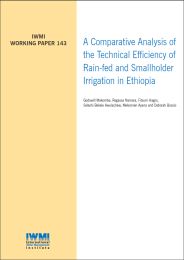A Comparative Analysis of the Technical Efficiency of Rain-fed and Smallholder Irrigation in Ethiopia.
Citation:
Makombe, G.; Namara, R.; Hagos, F.; Awulachew, S. B.; Ayana, M.; Bossio, D. 2011. A comparative analysis of the technical efficiency of rain-fed and smallholder irrigation in Ethiopia. Colombo, Sri Lanka: International Water Management Institute. 37p. (IWMI Working Paper 143). [doi: 10.5337/2011.202].
Abstract
Agriculture is the most significant contributor to Ethiopia’s economy. Most of the agricultural production is under rainfed conditions and thus extremely sensitive to rainfall variability. Irrigation development, including smallholder irrigation, is used by the Ethiopian Government to attempt to mitigate the effects of rainfall variability. In this study, we look at smallholder irrigation – modern and traditional irrigation systems. A detailed description of the cropping patterns is given. The stochastic frontier production function approach is used to estimate technical inefficiency, and constraints to production are analyzed. Since the traditional system is found to be efficient but on a lower production frontier, the study shows that significant gains can be made by raising the frontier of the traditional systems and increasing the efficiency of the modern systems. Among the production constraints studied were land preparation, soil fertility, weed control, pests and diseases, soil erosion, input access and moisture deficiency. The most significant constraints on the irrigated systems were input access and moisture deficiency.
ISBN 978-92-9090-740-4


